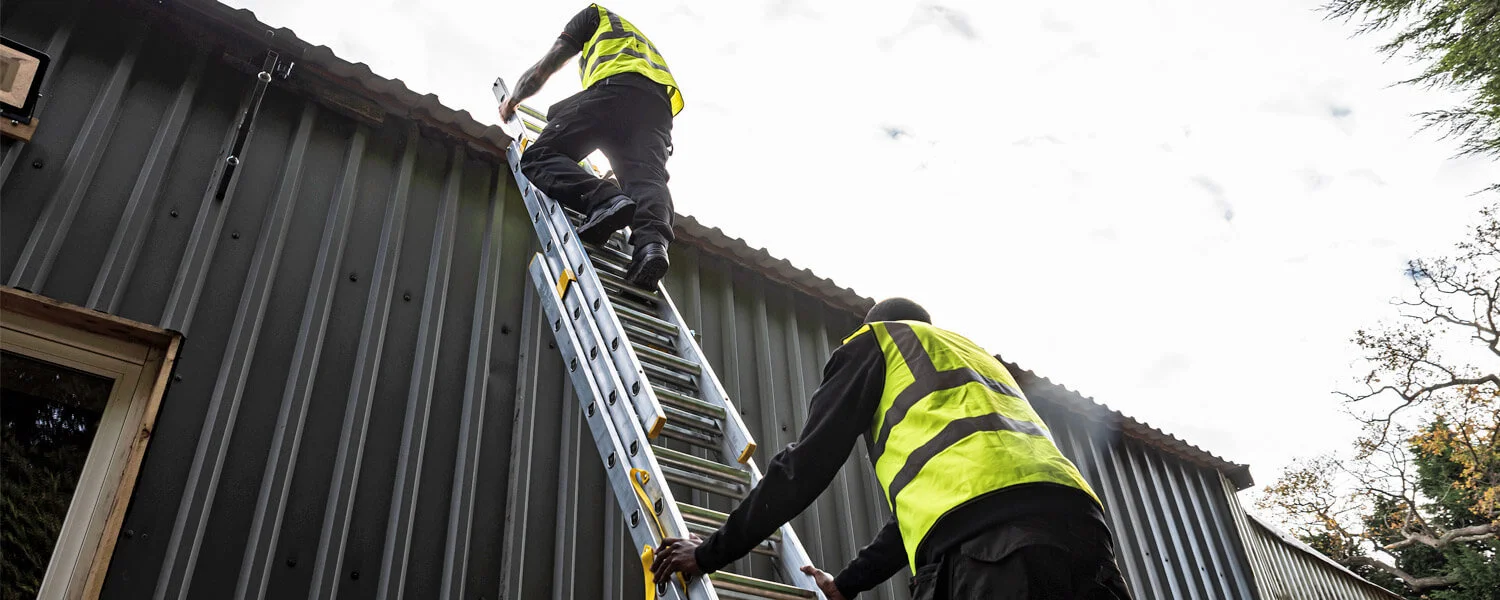Using a ladder or step ladder - the correct way
The LFI PRo Extender Triple Extension Ladder in use whilst following safe working practices.
SAFETY FIRST. ALWAYS. THAT’S LFI.
Ladders are a great piece of access equipment, helping you to reach heights of all sizes. When used correctly, ladders and stepladders are not very dangerous. However, ladders make up over a quarter of the falls from height recorded each year. That’s why here at LFI we push the importance of always working in the safest possible way, whatever environment you find yourself in.
What ladder do I need? Firstly, it depends on your task and what height you need to reach. An EN131 Non-Professional extension ladder, combination ladder or step ladder will help you reach safely to complete most domestic DIY jobs. If you are a trade professional or working in an industrial environment, you’ll need an EN131 Professional heavy-duty ladder to keep you safe.
How often do ladders need to be inspected? A ladder should be inspected each time you use it. Before using your chosen ladder, complete our Ladder Safety Inspection Sheet or Steps Safety Inspection Sheet and if you find yourself asking how many points of contact on a ladder should I keep, follow our handy guide to help you stay safe when working at height:
USING A LEANING LADDER
FOLLOW THE 1 IN 4 RULE
The 1 in 4 rule (one-in-four rule) ensures you are placing your ladder at the right angle. A leaning ladder should be at a 75-degree angle. The simplest way to achieve this is to have the ladder one unit out for every four units up.
THE 3 POINTS OF CONTACT RULE
Always climb using three points of contact. Try and work in the same way too if possible. Consistency is key to safety. Only let go of a handhold briefly whilst committing to the task. When climbing, you should always be facing the ladder and gripping it firmly. Make sure to use a tool belt when climbing to keep your hands free to hold on to the ladder.
THE BELT BUCKLE TEST
If the area where your belt buckle sits is outside of the ladder stiles, that means you are overreaching. Go back down and reposition the ladder. Never attempt to adjust the ladder while standing on the rungs.
MEASURE. THEN MEASURE AGAIN.
Is the ladder long and high enough for the task? You should never stretch upwards and never work from the top three rungs of your ladder. Never stand a ladder on a moveable object either. If it’s not stood on secure ground, it’s not safe.
NEVER OVERLOAD
Think about the worker’s height as well as the equipment or materials being carried. Double-check all the information you have before starting your task.
AVOID POWERLINES OVERHEAD
Never work within 6 metres horizontal to an overhead powerline (unless it has been made dead or protected with insulation). Any electrical work you’re about to undertake should involve a non-conductive ladder made from fibreglass or timber.
ALWAYS TIE OFF
No exceptions - make sure you tie off any leaning ladder. Use a strong upper resting point rather than a flexible or weak point. You should also consider using a stability device if required.
USING A STEP LADDER
CHECK YOUR FEET
Before starting, have a check over all four feet of the stepladder. Are they all in contact with the ground? Is the stepladder level with the ground? They should be! If this isn’t the case, don’t attempt to climb the stepladder and use it.
KEEP 3 POINTS OF CONTACT
Two feet and one hand. Simple. That’s the best way to stay safe when climbing up the stepladder. Need to use both your hands during a task? Use the stepladder to help support your body, creating that third point of contact required.
NEVER OVERLOAD
No exceptions here. Never overload your stepladder, ever! Aim to use light tools and/or materials and nothing else to keep the weight balanced.
NEVER OVERREACH
Overreaching is a must-not. Don’t stand on the top three steps either, unless a handhold is available above this point. Follow the working-at-height regulations at all times.
CHECK YOUR LOCKING DEVICE
Is your locking device engaged? It should be. Always double-check it is before making your climb.
BE AWARE OF SIDELOADING DANGERS
Sideloading actions, like drilling from the side, can be dangerous. Always aim to be facing the work you’re about to do unless a pre-completed risk assessment states otherwise. When a sideload is unavoidable, tie in the steps or take measures to ensure that the step ladder will not tip over.
To find the right product to help keep you safe when working at height, email our sales team.

